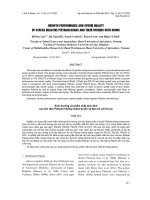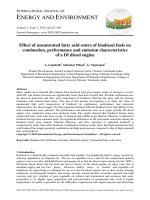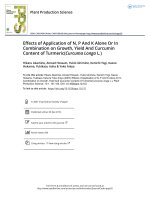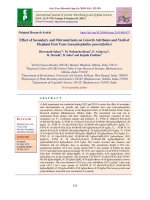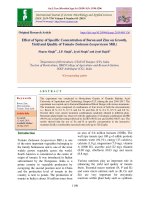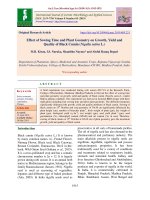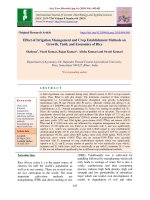Effect azola (Azola pinnata) feeding on growth performance and carcass traits of crossbred pigs
Bạn đang xem bản rút gọn của tài liệu. Xem và tải ngay bản đầy đủ của tài liệu tại đây (135.59 KB, 4 trang )
Int.J.Curr.Microbiol.App.Sci (2018) 7(6): 3813-3816
International Journal of Current Microbiology and Applied Sciences
ISSN: 2319-7706 Volume 7 Number 06 (2018)
Journal homepage:
Original Research Article
/>
Effect Azola (Azola pinnata) Feeding on Growth Performance and
Carcass Traits of Crossbred Pigs
Kiranpal Singh Saini*, Biswajit Roy, G. P. Lakhani, A. K. Jain and Sudipta Ghosh
Department of Livestock Production and Management, College of Veterinary Science and
Animal Husbandry, NDVSU, Jabalpur, M.P., India
*Corresponding author
ABSTRACT
Keywords
Crossbred pigs,
azolla, average
daily gain, carcass
traits
Article Info
Accepted:
28 May 2018
Available Online:
10 June 2018
The study was conducted at Livestock farm, Adhartal, College of Veterinary Science &
Animal Husbandry, N.D.V.S.U., Jabalpur (M.P.) for five months. A total of 21 crossbred
pigs (about 4 months of age) were selected and randomly distributed in three different
groups (G1, G2 and G3) each group containing seven animals. Diets were formulated as
per ICAR (2013) standard. Composition of the diets (Table-1) are as follows; G1(Control); concentrate mixture-1, G-2; concentrate mixture-2 (85%) + dried azolla (15%),
G-3; concentrate mixture-3 (70%) + dried azolla (30%). At the end of the experiment, the
two animals from each group were slaughtered for carcass evaluation. Daily feed intake
was significantly (P<0.05) varied among the groups. Highest daily feed intake (kg/pig/day)
was observed in G3 group (1.99) and lowest value observed in G1 group (1.90). Average
daily gain (ADG) were significantly (P<0.01) different and highest ADG (g/pig) was
observed in group G2 (385.64) and lowest ADG (g/pig) observed in G1 group (359.01).
Carcass characteristics were not significantly varied among the experimental groups.
Finally, the study concluded that azolla could be fed to the growing crossbred pigs
Introduction
The pig rearing constitutes the livelihood of
rural poor belonging to the lowest socioeconomic strata. The total pig population in
India was 10.29 millions and contributes
around 2.01% of total livestock population
(Livestock census, 2012). Pigs are the most
prolific among the domestic animals. Their
growth rate is fast and they use cereal byproducts efficiently and give higher dressing
percentage at younger ages. There is
considerable scope for pig farming as a
profitable enterprise in rural areas (Tudu et al.,
2015). They consume wide variety of
feedstuffs including industrial waste, kitchen
waste, plant materials, etc. Among the various
alternate feed resources, a wonderful plant
called Azolla can be used as livestock feed.
Azolla has long been used as green manure. It
is very rich in proteins, essential amino acids,
vitamins (A, B12 and β carotene) and growth
promoter intermediaries and minerals viz.,
calcium, phosphorus, potassium, iron, copper,
magnesium, etc. (Letermea et al., 2010).
Azolla can be economically fed to sheep, goat,
pig and rabbits as feed substitute (Pillai et al.,
2002). In India, azolla is found floating on the
3813
Int.J.Curr.Microbiol.App.Sci (2018) 7(6): 3813-3816
water in the shallow ditches and in channels.
Azolla can fix atmospheric nitrogen with help
of blue green algae, Anabaena azollae, found
in cavities of dorsal part of leaves. This fact
makes the azolla tend to contain relatively
high levels of nitrogen and can be a protein
source for animal feeding. There is paucity of
information regarding use of azolla in the diet
of crossbred pigs. Hence, the present study
was designed to evaluate the effect of azolla
feeding on growth performance and carcass
traits of crossbred pigs.
Materials and Methods
The study was conducted at pig unit of
Livestock farm, Adhartal, College of
Veterinary Science & A.H., Nanaji Deshmukh
Veterinary Science University, Jabalpur
(M.P.). The study was conducted for a period
of nine months (July, 2016 to March, 2017) at
Livestock farm, Adhartal, Jabalpur. A total of
21 growing crossbred pigs were randomly
assigned into three different groups, with
seven animals in each group. The preexperimental period of 15 days was allowed to
get the experimental animals adjusted before
actual start of actual experiment. Diets were
formulated as per ICAR (2013) standard.
Animals of the group- 1 was receiving only
basal diet, whereas diet of the group-2 and
group-3 were 15% dried azola + 85% basal
diet and 30% dried azolla + 70% basal diet,
respectively. Other than feed, all the pigs were
maintained under same managemental
conditions. Body weight of all animals was
recorded fortnightly basis in the morning
before feeding with use of platform type
electronic weighing balance. At the end of the
experiment, the two animals from each group
were slaughtered for carcass evaluation.
Proper fasting one day prior to slaughter was
done. The weight before slaughter and antemortem examinations was carried out. The
fallowing measurements were taken after
slaughter of the animals. Carcass traits like
dressing percentage, carcass length, backfat
thickness were measured. Data were analysed,
using ANOVA described by Snedcor and
Cochran (1994). Means showing significant
differences in the ANOVA table were
compared using the Duncan Multiple Range
Test (Steel and Torrie, 1980).
Results and Discussion
Daily feed intake was evaluated at fortnight
interval and indicated in table 2. Overall daily
feed intake was not significantly varied among
the groups. Highest daily feed intake (kg/pig)
was observed in G3 group (1.99±0.01) and
lowest value observed in G1 group
(1.90±0.01). It was also observed in the
present study that as the inclusion of azolla in
the diet increases above 50 percent level, the
feed intake starts declining. In G3 group, 30%
azolla was included in the diet and
significantly (P<0.05) lower feed intake was
observed inG1 group in comparison to the G2,
and G3 groups. Higher feed intake was
observed in G3 group (1.99) in comparison to
the G2 group (1.92), however difference was
non-significant. In the present study, overall
daily feed intake was not significantly varied
among the groups. Overall average feed intake
in terms of per cent body of crossbred growing
pigs were 3.39±0.12, 3.37±0.16, and
3.46±0.19 per cent, respectively for the G1,
G2, and G3 groups and no significant
difference were observed among the
experimental groups. The result obtained in
the present study is in accordance with the
reports of Cherryl et al., (2013). It is
supported by the findings of Shamna et al.,
(2013), who have reported that growth and
feed conversion efficiency in quails on Azolla
pinnata at 5% displacement level of the basal
ration was as good as the basal diet, besides it
was more economical due to less expenditure
on feed. In the present study, 15% and 30%
azolla was added to the diet of group 2 and
group 3, respectively.
3814
Int.J.Curr.Microbiol.App.Sci (2018) 7(6): 3813-3816
Table.1 Gross composition (%) of concentrate mixture/diet used in the experiment
Ingredients
Proportion (Kg)
Yellow maize
37
Rice polish
16.5
Wheat bran
14
Undecorticated ground nut cake
14
De-oiled rice polish
10
Jawala fish(60%Protein)
6
Mineral mixture
2
Common salt
0.5
Total
100
Table.2 Effect of azolla feeding on growth performance and carcass traits of crossbred pigs
Groups
G1
G2
Feed intake and growth performance
1.90±0.01
1.92±0.0.01
Average daily feed intake
(kg/pig/day)
0.359±12.50
0.385±13.20
Average daily gain
(kg/pig/day)
5.46±0.20
5.24±0.17
Feed conversion ratio (FCR)
Carcass traits
91.15±4.96
87.90±3.53
Fasting weight (kg)
59.30±2.96
63.70±3.21
Hot carcass weight (kg)
67.47±1.93
68.27±2.96
Dressing percent
84.77±5.27
86.12±4.92
Carcass length (cm)
Back fat thickness (mm)
35.71±1.29
35.21±1.71
At first ribs
16.37±1.02
16.22±1.22
At last ribs
17.12±0.91
14.92±0.79
At rump
Average daily gain (ADG) of crossbred
growing pigs was presented in Table 2.
Statistical analysis of the parameter revealed
that they were significantly (P<0.01)
different.
Highest ADG (kg/pig/day) was observed in
group G2 (0.385) and lowest ADG
(kg/pig/day) observed in G1 group (0.359).
Initial average body weights (kg/pig) of the
experimental groups were almost similar and
ranges from 32.43 to 32.72. At the end of the
experiment lowest average body weights
G3
1.99±0.0.01
0.382±12.96
5.50±0.18
93.35±5.26
61.70±3.92
67.71±2.91
85.37±4.39
36.21±1.92
16.96±0.97
15.96±0.71
(kg/pig) was found in the G1 group (87.72)
and highest in the G3 group (91.42).
Efficiency of utilisation of feed was measured
through feed conversion ratio and protein
conversion ratio. In the present study, overall
FCR was significantly (P<0.01) varied among
the experimental groups. Lowest FCR value
was reported in G2 group (5.24) and highest
in G3 group (5.50). FCR value indicated that
how efficiently the feedstuffs are utilised for
the production purpose. Parthasarthy et al.,
(2003) studies conducted with desi pigs fed
3815
Int.J.Curr.Microbiol.App.Sci (2018) 7(6): 3813-3816
with isonitrogenous concentrate mixtures
containing sun-dried azolla revealed that
azolla can be incorporated up to 30 per cent
without any considerable adverse effect on
growth.
Carcass characteristics were determined after
slaughter of experimental pigs. Two animals
from each group having higher body weight
were slaughter after completion of
experimental period. To evaluate the carcass
characteristics, parameters like hot carcass
weight, dressing per cent, carcass length and
back fat thickness were observed. Back fat
thickness was measured in three points
namely; first ribs, last ribs and rump. Carcass
characteristics are presented in table 2.
Dressing per cent were 67.47±1.93,
68.27±2.97 and 67.71±2.91, respectively for
the G1, G2, and G3, groups and the values
were not significantly varied. Carcass length
and back fat thickness was also not
significantly varied among the groups.
Similar findings were observed in other
studies (Wadhwani et al., 2010., Tamang and
Samanta, 1993), with the feeding of azolla.
Finally, the study concluded that azolla can
replace 30% concentrate mixture without
affecting body weight gain, feed intake and
carcass traits.
References
Cherryl DM, Prasad RMV, Jagadeeswara RS,
Jayalaxmi P and Eswar RB. 2013. Effect of
inclusion of Azolla pinnata on the
haematological and carcass characteristics
of crossbred large white yorkshire pigs.
Veterinary World, 7(2): 78-82.
ICAR 2013. Nutrient Requirements of Pig. Indian
Council of Agriculture Research, New
Delhi.
Letermea P, Angela M, Diana C and Buldgen A.
2010. Nutritional value and intake of
aquatic ferns (Azolla filiculoides) in sows.
Animal Feed Science and Technology,
155(1): 55-64.
Livestock census 2012. Department of Animal
Husbandry and Dairying, Ministry of
Agriculture, Government of India, New
Delhi.
Parthasarthy R, Gowri AM, Gajendran K and
Hariharan P. 2003. Azolla as feed source
for desi pigs. Azolla in pigs: Cheiron,
Farmers Training Centre, Tamilnadu
Veterinary Animal Science University,
Tiruvarur.
Pillai PK, Premalatha S and Rajamony S. 2002.
Azolla-a sustainable feed substitute for
livestock, leisa India, 4: 15-17.
Snedecor GW and Cochran WG. 1994. Statistical
Methods, Affiliated East West Press, New
Delhi, 142 p.
Steel RGD and Torrie JH. 1980. Principles and
procedures of statistics. A biometrical
approach. 2nd Edn. Mc Graw Hill Book Co.,
New York, NY, USA.
Tamang Y and Samanta G. 1993. Feeding value
of Azolla (Azolla pinnata) an aquatic fern
in Black Bengal goats. Indian Journal of
Animal Science, 63(2): 188-191.
Tudu NK, Pyne SK, Goswami KK, Ghoshand N
and Roy DC. 2015. Socio-Economic profile
and management practices of tribal pig
farmers in West Bengal. Indian Journal of
Research, 4: 1-4.
Wadhwani KN, Parnerkar S, Saiyed LH and Patel
AM. 2010. Feedlot performance of weaner
lambs on conventional and nonconventional total mixed ration. Indian
Journal of Animal Research, 44(1): 16-21.
How to cite this article:
Kiranpal Singh Saini, Biswajit Roy, G. P. Lakhani, A. K. Jain and Sudipta Ghosh. 2018. Effect
Azola (Azola pinnata) Feeding on Growth Performance and Carcass Traits of Crossbred Pigs.
Int.J.Curr.Microbiol.App.Sci. 7(06): 3813-3816. doi: />
3816
